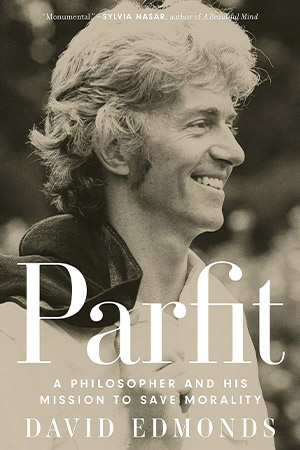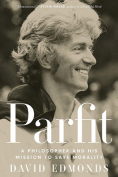Parfit: A Philosopher and His Mission to Save Morality by David Edmonds
 Princeton, New Jersey. Princeton University Press. 2023. 408 pages.
Princeton, New Jersey. Princeton University Press. 2023. 408 pages.
The first half of the twentieth century was a difficult period for moral and political philosophy, as dominant currents in analytic and language philosophy viewed normative statements generally as unscientific. It was not until the years leading up to John Rawls’s 1971 publication of A Theory of Justice that the field moved back onto the center stage of Western philosophy. In the same year, a young Oxford philosopher named Derek Parfit rose to prominence after the publication of his first paper, “Personal Identity.” Albeit much less known to the wider public, Parfit today is often named alongside Rawls as the leading moral philosopher of the twentieth century. With Parfit: A Philosopher and His Mission to Save Morality, British journalist and philosopher David Edmonds offers the first book-length biography of this curious and highly original thinker who died in 2017.
During his undergraduate years at Oxford, Edmonds studied with Parfit and got to know him better when Parfit’s wife, philosopher Janet Radcliffe Richards, supervised his PhD work. In Parfit, Edmonds writes of a cloistered and dull life that at the same time was wonderfully eccentric and impactful. Parfit was born in 1942 in China to a family of English missionaries. Once back in the UK, young Derek started rising through the country’s elite academic institutions. He soon lost his faith but never his zeal to convert people to what he believed to be true. Parfit was an idiosyncratic individual; and as alien as some of his philosophy appears, the philosopher himself often seemed more outlandish still. Edmonds speculates, as have many others, about the neuro-atypicality of his subject. Parfit would routinely wear the same clothes, eat the same meal, make others uncomfortable with his lack of awareness of personal space, or be too nonchalant about his own nudity.
When it came to philosophy, Parfit could be incredibly generous, sometimes working late into the night to provide pages of detailed commentary on the arguments of students and established philosophers alike. Yet when presented with others’ personal problems, he would often be, seemingly unwillingly, cold. Parfit’s philosophy was novel, both in its arguments, laden with innovative thought experiments, and in the conclusions derived from them. Many philosophers have described the transformative impact Parfit’s 1984 magnum opus, Reasons and Persons, has had on them—the rigor of its arguments, leaving little room for attack, yet often yielding surprisingly novel insights. Reasons and Persons focuses on a variety of topics, with identity remaining a central concern throughout. Similar to Hume or Buddhism, it makes the case that what matters is not our identity but our psychological continuity—a position that has implications for how we cast blame, treat crimes of the past, and people yet to be born. The latter topic was not pioneered by Parfit, but, like Freud with the subconscious, it was he who brought depth and wide recognition to the moral importance of future people.
In the twenty-first century, Parfit’s ideas paved the way for Effective Altruism (EA). “If [Peter] Singer was the intellectual father of the movement, Parfit was its grandfather,” Edmonds contends. And indeed, beyond Singer, many of EA’s lead figures, such as Toby Ord or Nick Bostrom, were notably influenced by Parfit. However, his reach did not remain just indirect. Where EA initially focused solely on relieving “the suffering of people living today, Parfit argued, there should be an option that at least some of the money donated be earmarked for the problems of tomorrow.” With this critique, Parfit helped shift the movement’s focus, which today includes humanity’s existential risks and, thus, the lives and quality of life of future humans.
Given the relative dearth of outside events, it is surprising how captivating Edmonds’s writing is. The book is structured chronologically and establishes its subject firmly as a pivotal figure in the moral philosophy of the twentieth and twenty-first centuries. Parfit was a perfectionist who published only two books (albeit with a collective page count nearing three thousand) and would torment his publishers and colleagues with never-ending sets of drafts and revisions. As an adult, photography was his only other passion outside of philosophy. For three decades, every year, he would travel to Venice and St. Petersburg to photograph the ever-same buildings. Edmonds arranges high-quality prints of some of these shots among the pages of his engaging biography.
Parfit was not a public intellectual like Singer, nor is his work regularly cited by leading politicians in the English-speaking world, like Rawls’s. Edmonds calls him a “philosopher’s philosopher,” and, indeed, his direct influence was almost fully limited to academic philosophy, where his reach and impact were vast. What remains after reading Edmond’s biography is certainly the particularity of his subject’s character, exemplified by a host of funny and often bizarre anecdotes. But we are also left convinced of Parfit’s dedication to philosophy, no matter whether it was his own, a colleague’s, or a student’s—and the influence he thus exerted on the development of his field and the minds of many working within it.
Today Parfit lives on, not only in academic circles and the Effective Altruism movement, but also in the belief systems of public intellectuals such as Sam Harris. Edmonds’s strangely entertaining book is an important step in opening the life and thoughts of this intellectual titan and reclusive academic to the wider public.
Felix Haas
Zurich








































